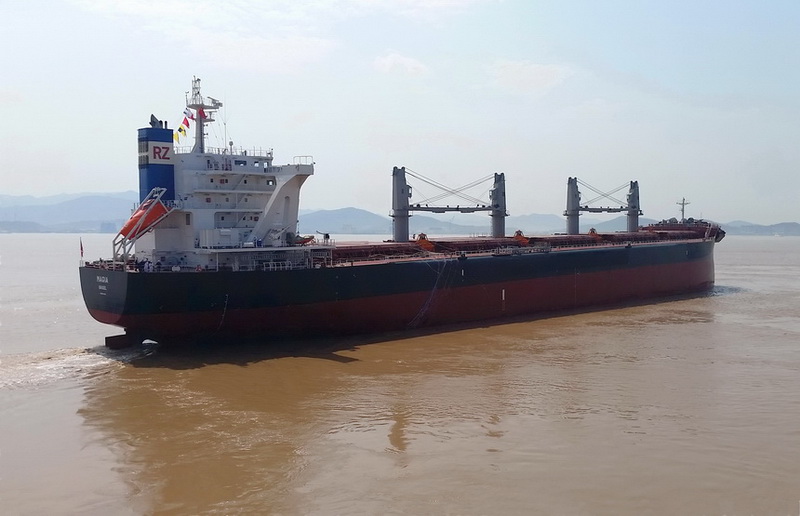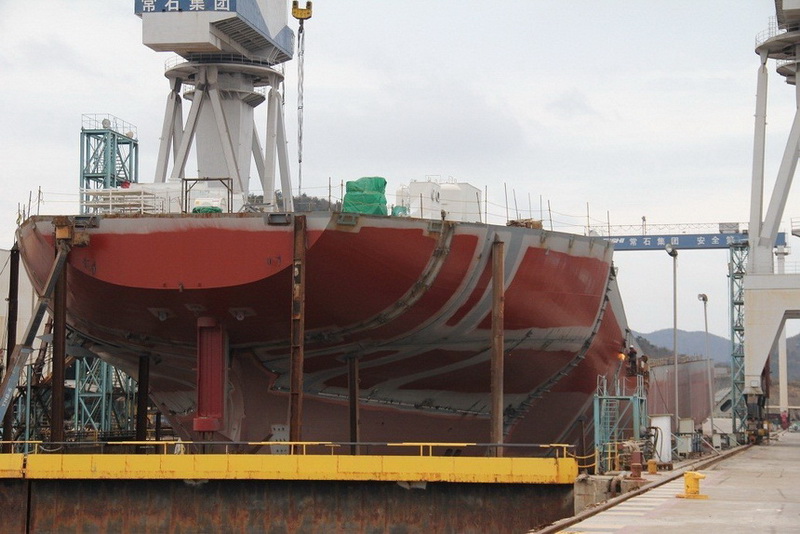
MAGIA
IMO No.: 9710036
Schiffstyp / Ship's type: Motor / Massengutfrachter / Bulkcarrier (Supra / Ultramax)
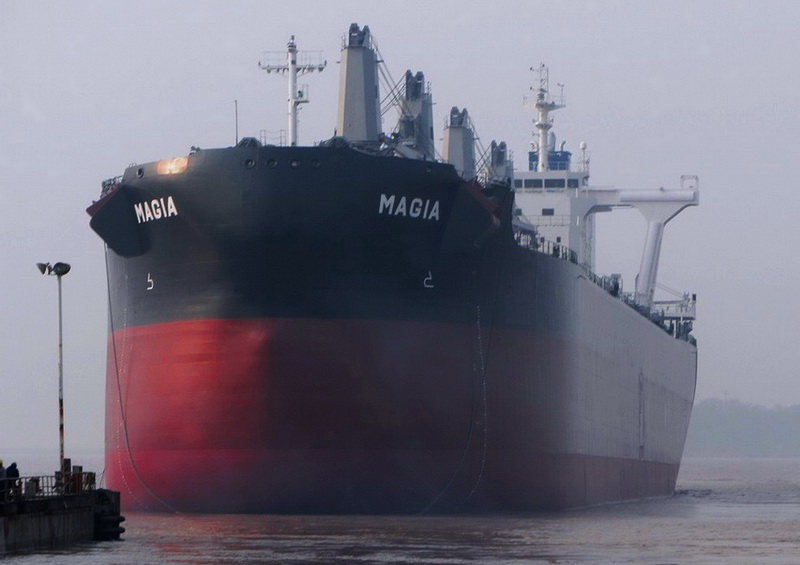
![]()
Bau / Construction
| Bauwerft / Shipyard: | Tsuneishi Group (Zhoushan) Shipbuilding Inc., Zhoushan,Daishan County ZJ, P. R. of China | ||
| Bau Nr. / Hull / Yard No: | SS-158 | Baujahr / Year of built: | 2015 |
| Kiellegung / Keel laying: | 15.10.2014 | Stapellauf / Launching: | 20.12.2014 |
| Ablieferung / Delivery: | 31.03.2015 | ||
![]()
Reeder - Manager / Shipping company - Manager
| Eigner / Registered owner: | Sextant Maritime AG, Zug | ||
| Reeder / Shipping Company (Manager): | Reederei Zürich AG, Zürich | ||
| Tech. Management / Technical Mgmt: | Reederei Zürich AG, Zürich | ||
| Management von / from: | 31.03.2015 | Management bis / until: | |
| Registerhafen / Homeport: | Basel | Flagge / flag: | Switzerland (CHE) |
| Rufzeichen / Call sign: | HBLO | Register-Nr. / Official No: | 214 |
| Registrier Datum / Date: | 31.03.2015 | Register Streichung / Deletion: | |
| Verbleib / Fate: | In Fahrt / In service | ||
![]()
Vermessung / Tonnage
| BRZ / GT: | 32'540 | Länge / Length: | 189.99 | Meter | ||
| NRZ / NT: | 19'282 | Breite / Breadth: | 32.296 | Meter | Passenger: | - |
| DWT: | 57'586 | Tiefgang / Draft: | 12.818 | Meter | Crew: | 22 |
| Lightship tons: | n.a. | Tiefe / Depth: | 18.018 | Meter | ||
| Ladegeschirr / Cargogear: | 4 Kräne à 30 Tonnen SWL / 4 Cranes of 30 tonnes SWL (Safe Working Load) | |||||
![]()
Maschine / Machinery
| Maschinen-Typ / Engine type: | 7-Cyl. 7S50ME-B9.3 MAN (Maschinenfabrik Augsburg Nürnberg) - B&W (Burmeister & Wain) | Maschinenhersteller / Engine builder: | Mitsui Engineering & Shipbuilding Co. Ltd., Japan |
| Leistung / Power: | 7'000kW / 9'520 PS - Hp @ 92.9 RPM (Service rating, with Shaft Generator) |
| Geschwindigkeit / Speed: | 14.5 Knoten / Knots |
| Antrieb / Propulsion: | 1 Festpropeller / Fixed blade propeller |
![]()
Registrierte Schiffsnamen / Registered ship's names
| Datum / Date | Schiffsname / Name | Heimathafen / Homeport |
| 31.03.2015 | MAGIA | Basel |
| Verbleib des Schiffes / Fate of vessel: | In Fahrt / In service |
![]()
Schiffsgeschichte

Die Reederei Zürich AG, Zürich bestellte drei Standard Bulk Carriers im Frühjahr 2013 bei der japanischen Schiffbau Gruppe Tsuneishi Shipbuilding Co. Ltd. Fukuyama und Hiroshima, die auch Bauwerften in China und den Philippinen betreibt. Die MAGIA wurde nach dem neu entwickelten Design TESS-58 AEROLINE von der Tsuneishi Group (Zhoushan) Shipbuilding in Zhoushan, China gebaut. Zhoushan ist eine Stadt auf den Zhoushan-Inseln südlich der Yangtse-Mündung bei Shanghai. Eine mächtige Hängebrücke führt von Ningbo auf dem Festland hinüber nach Zhoushan. Am 31.03.2015 wurde die MAGIA an die Reederei abgeliefert und die Schweizer Flagge gehisst (Reg. Nr. 214, Rufzeichen: HBLO, Eignerfirma: Sextant Maritime AG, Zug). Der Name MAGIA ist lateinisch und bedeutet Maienfeld, ein kleines Städtchen bei Chur im Kanton Graubünden. Die komplette Besatzung von 22 Mann kommt aus den Philippinen. Die ersten zwei Reisen führten von China nach Indonesien, wo Kohle für Indien geladen wurde, nachher fuhr die MAGIA in Ballast nach Australien um Getreide für Lagos in Nigeria zu laden. Das Schiff fährt weltweit und ist in Zeitcharter eingesetzt. SwissShips, BL, HPS, MB, Juli 2015 Zusätzliche Informationen und Geschichten Die MAGIA ist das erste Schiff für die Reederei Zürich, das nach dem neuen, verbesserten Design TESS-58 AEROLINE gebaut wurde. Grundsätzlich nach dem bewährten Typ TESS-58 (Tsuneishi Economical Standard Ship von 58'000 Tonnen Tragfähigkeit) konstruiert, wurde nun ein spezielles Augenmerk auf den Luftwiderstand gelegt. Das Schiff hat 5 Laderäume und 5 Ladeluken, das Fassungsvermögen beträgt total 72'087 m3. Für den Ladungsumschlag sind vier Kräne von je 30 Tonnen Tragfähigkeit und den dazugehörenden Greifern für Bulkladung installiert. Die MAGIA ist klassifiziert bei NKK, Nippon Kaiji Kyokai, der japanischen Klassifikationsgesellschaft. Der obere Teil des Buges und die schmalen Aufbauten sind aerodynamisch konzipiert, zusammen mit einer optimierten Rumpfform ergibt sich eine Brennstoffersparnis von rund 4 Tonnen pro Tag, gegenüber dem älteren Schiffstyp. Die Hauptmaschine mit Wellengenerator verbraucht ungefähr 28.5 Tonnen Schweröl pro Tag, bei einer Geschwindigkeit von ungefähr 14,5 Knoten (die älteren Schiffe verbrauchen etwas mehr als 32 Tonnen pro Tag). Die Turbolader der Hauptmaschine saugen nicht mehr die heisse Luft aus dem Maschinenraum an, sondern werden direkt mit Aussenluft versorgt. Diese Luft wird über die steuerbord Stütze der Brückennock angesogen und über Luftkanäle in die Turbolader geleitet. Die Theorie besagt, dass so kühlere Luft in die Maschine kommt und somit der Wirkungsgrad steigt. Bleibt zu hoffen, dass bei stürmischer See nicht zu viel Salzwasser in die Maschine eindringt. Der Brennstoff liegt nicht mehr im Doppelboden, sondern lagert in den Top Wing Tanks entlang der Laderäume 4 und 5, die zudem von der Bordwand durch Ballast Wasser Tanks getrennt sind. Auf der Brücke werden nur noch elektronische Seekarten benützt. Es gibt keine Seekarten aus Papier mehr, die Seekarten werden über Satellit runtergeladen und sind auch immer auf dem neuesten Stand. Die Steuerleute müssen nicht mehr in mühsamer, Stunden langer Arbeit die Karten korrigieren und die Maschinisten können die alten Karten nicht mehr als Dichtungsmaterial verwenden. Ein sogenannter "Voyage Data Recorder" befindet sich auf dem Peildeck (Monkey Island), welcher wie eine Blackbox bei einem Flugzeug geborgen werden kann. Bei dem neusten Schiff, der CURIA, würde sich bei einem allfälligen Schiffsuntergang eine Kapsel auch automatisch lösen und auf der Wasseroberfläche schwimmen. Er nimmt alle wichtigen Navigations- und Maschinendaten, sowie die Gespräche auf der Brücke auf. Zum Auffinden sendet er Peilzeichen aus, ähnlich der "Black-Box" in Flugzeugen. Die Seeleute sind in Einzelkabinen untergebracht und haben Anschluss für E-mail und Internet, nach heutigen Standards eines der wichtigsten Kriterien für das Wohlbefinden an Bord (so haben es die Seeleutegewerkschaften in Umfragen rausgefunden). SwissShips, BL, HPS, August 2015 |
![]()
Historique des navires

L’armateur Reederei Zürich SA à Zürich a commandé 3 vraquiers standard au printemps 2013 auprès du groupe de construction navale japonais Tsuneishi Shipbuilding Co. Ltd. Fukuyama et Hiroshima, entreprise qui dispose également de chantiers navals en Chine et aux Philippines. Le MAGIA a été construit selon la conception nouvellement élaborée sous le nom de TESS-58 AEROLINE par Tsuneishi Group (Zhoushan) Shipbuilding à Zhoushan en Chine. Zhoushan (anciennement Chusan) est une ville sur les îles Zhoushan, au sud de l’embouchure du fleuve Yang Tsé, non loin de Shanghai. Un fantastique pont suspendu uni Ningbo sur la terre ferme à Zhoushan. Le 31-03-2015 le MAGIA a été remis à l’armateur et le pavillon suisse a été hissé (No de registre 214, indicatif d’appel HBLO, propriétaire Sextant Maritime AG à Zoug). Le nom MAGIA est la transcription en latin de Maienfeld, une petite ville près de Coire dans les Grisons. L’équipage se compose de 22 marins Philippins. Informations techniques et histoire Le MAGIA est le premier navire construit pour la Reederei Zürich selon les critères Design TESS-58 AEROLINE. Fondamentalement, les critères de TESS-58 (Tsuneishi Economical Standard Ship de 58'000 Tonnes de chargement) donnent une grande attention à l’aspect de l’aérodynamique de ces navires. Le vraquier dispose de 5 cales et de 5 écoutilles d’un volume global de 72'087 m3. Quatre grues de 30 tonnes chacune et leurs bennes correspondantes permettent les opérations de chargement déchargement du vrac. Le MAGIA répond aux normes de la société de classification NKK, le Nippon Kaiji Kyokai. La partie supérieure de l’étrave et les fines superstructures sont conçues sur des règles d’aérodynamisme qui, avec un design optimisé de la carène, permettent une économie de carburant de pratiquement 4 tonnes par jour par rapport aux navires d’ancienne conception. La machine principale avec sa génératrice d’arbre utilise 28.5 tonnes d’huile lourde par jour avec une vitesse de croisière de 14.5 nœuds (les anciens navires utilisent plus de 32 tonnes par jour). Le turbo de la machine principale ne prend plus l’air dans la salle des machines, mais d’une source extérieure. Cet air est capté au niveau du support de l’aile de la passerelle tribord et il est directement conduit au turbo par une canalisation. La théorie prône que plus l’air qui entre dans la machine est frais, plus l’efficacité du moteur augmente. Reste à espérer qu’en navigation par mauvais temps il n’y ait pas trop d’entrée d’embruns salés dans la machine. Le carburant ne se trouve plus dans les double-fonds, mais il est stocké dans des Top Wing Tanks le long des cales 4 et 5 et qui, en plus, sont séparés de la muraille par les tanks de ballast. Sur la passerelle, il n’est plus fait usage que de cartes électroniques (ECDIS, Electronic Chart Display and Information System). Il n’y a plus de cartes en papier ; les cartes sont chargées via satellites et sont toujours révisées à jour. Les Officiers de pont n’ont ainsi plus à passer des heures et des heures à fastidieusement corriger à la main les cartes nautiques, même si les mécaniciens perdent ainsi le précieux matériel que représentaient les cartes périmées pour créer des emballages. Un enregistreur de données se trouve sur le pont des singes, ce qui permet de stocker des données, tout comme la boîte noir des avions. Sur le dernier des navires, le CURIA, l’enregistreur de données flottera automatiquement en cas de perte du navire. Le dispositif enregistre tous les événements importants de la navigation ainsi que les données de la machine, de même que les conversations sur la passerelle. Pour récupérer ces enregistrements l’appareil émet des signaux radio de localisation, tout comme la boîte noire de l’aviation. Tous les marins sont logés dans des cabines individuelles avec connexion E-mail et Internet, comme le prévoient les standards actuels, un des plus importants critères de bien-être à bord prévu par les syndicats des marins britanniques. SwissShips 14.10.2018-HPS, MB, Pierre-André Reymond |
![]()
Cronistoria delle navi

La Reederei Zürich AG, Zurigo, nella primavera del 2013 ordina 3 rinfusiere standard (standard Bulk Carriers) presso il gruppo cantieristico Giapponese Tsuneishi Shipbuilding Co. Ltd. Fukuyama e Hiroshima, il quale opera anche in Cina e sulle Filippine. La MAGIA viene costruita secondo il nuovo design TESS-58 AEROLINE sviluppato da Tsuneishi Group (Zhoushan) Shipbuilding a Zhoushan, Cina. Zhoushan è una città sulle isole Zhoushan a sud della foce del fiume Yangtse nei paraggi di Shanghai. Un'immenso ponte sospeso collega Ningbo sulla terraferma con Zhoushan. La MAGIA viene consegnata alla società armatrice il 31-03-2015 mettendola sotto bandiera Svizzera (numero matricola: 214, nominativo internzionale HBLO, proprietaria: Sextant Maritime AG, Zug). Il nome MAGIA proviene dal latino e significa Maienfeld, una piccola cittadina nei pressi di Coria nel cantone dei grigioni. L'intero equipaggio composto da 22 persone proviene dalle Filippine. I primi due viaggi la esegue dalla Cina all'Indonesia, dove viene caricato un carico di carbone per l'India, dopodiche la MAGIA in zavorra è diretta in Australia per imbarcare un carico di grano per Lagos in Nigeria. La nave opera in tutto il mondo ed è noleggiata a tempo. SwissShips, BL, HPS, HM, MB, Luglio 2015 Ulteriori informazioni e storie La MAGIA è la prima nave della Reederei Zürich, la quale viene costruita secondo il nuovo, migliorato disegno TESS-58 AEROLINE. In sostanza costruia secondo l'approvato tipo TESS-58 (Tsuneishi Economical Standard Ship di 58'000 tonn. di portata), rivolgendo particolare attenzione all'aerodinamica. La nave ha 5 stive e 5 boccaporti, con una capacità di 72'087 m³. Per la movimentazione del carico sono installate 4 gru con una portata di 30 tonn. ciascuna con le rispettive benne per i carichi alla rinfusa. La MAGIA è classificata da NKK, Nippon Kaiji Kyokai, l'ente di classificazione delle navi Giapponese. La parte superiore della prua e le sovvrastrutture sono di concezione aerodinamica, assieme ad una forma dello scafo ottimale comporta un risparmio di carburante di 4 tonn. al giorno, rispetto al vecchio tipo. Il motore principale con un generatore asse consuma ca. 28.5 tonn. di olio pesante al giorno, ad una velocità di 14,5 nodi (le navi del vecchio tipo consumavano poco più di 32 tonn. al giorno). I turbocompressori del motore principale non aspirano più l'aria calda del locale motore, bensì vengono alimentati direttamente con aria dall'esterno. Tale aria viene aspirata attraverso il sostegno dell'aletta di dritta e tramite condotte diretta ai turbocompressori. La teoria dice che in questo modo il motore riceve aria più fredda aumentando il grado di efficienza. C'è solo da sperare che con mare mosso non penetri troppa acqua salata nei motori. Il combustibile non viene più imbarcato nei doppi fondi bensì nelle casse alte laterali lungo le stive 4 e 5, le quali ulteriormente sono separate da casse di zavorra a murata. Per la navigazione vengono impiegate esclusivamente carte eletroniche. A bordo della MAGIA non si trovano più carte in forma tradizionale, cioè cartacee, le carte vengono scaricate via satellite e sono sempre aggiornate. L'ufficiale di coperta adetto non deve più correggere le carte faticosamente spendendo parecchio tempo per tale lavoro ed i macchinisti non possono più utilizzare le vecchie carte scadute come materiale per guarnizioni. Un cosìdetto "Voyage Data Recorder" si trova sull'aletta (Monkey Island), il quale in caso potrebbe essere recuperato come da un aeroplano. Sulla nave più recente, la CURIA, in caso di affondamento automaticamente si staccerebbe una capsula dal fissaggio e rimanerebbe a galla. Ha il compito di registrare tutte le informazioni importanti inerenti la navigazione, dati dell'apparato motore come anche le conversazioni sul ponte di comando. Per il ritrovamento in caso di affondamento della nave emette segnali in modo di poterlo rilevare, simile alla "Black-Box" degli aeroplani. L'equipaggio è sistemato in cabine singole e dispone di connessione internet e e-mail, secondo lo standard di questi tempi un criterio molto importante per il benessere del personale imbarcato (ciò è stato ricavato tramite un sondaggio da parte delle associazioni sindacali). SwissShips, BL, HPS, HM, Luglio 2015 |
![]()
History

The Reederei Zürich AG (Zürich Shipping Ltd) ordered three standard bulk carriers in spring 2013 with the Japanese ship building group Tsuneishi Shipbuilding Co. Ltd. Fukuyama and Hiroshima, which operates also ship yards in China and the Philippines. The MAGIA, the first vessel was built according to the newly developed design TESS-58 AEROLINE at Tsuneishi Group (Zhoushan) Shipbuilding, Zhoushan, China. Zhoushan is a city on the Zhoushan-Islands, south of the mouth of the Yangtse River near Shanghai. A mighty suspension bridge leads from Ningbo on the mainland to Zhoushan. On 31.03.2015 the MAGIA was delivered to her owners and the Swiss flag was hoisted (off. No: 214, call sign: HBLO, registered owner: Sextant Maritime AG, Zug). The name MAGIA is Latin and means Maienfeld, a small medieval town near Chur in the canton of Grisons. The complete crew of 22 persons comes from the Philippines. The first two voyages went from China to Indonesia, where coal was loaded for India, then in ballast to Australia to load a cargo of grain for Lagos, Nigeria. The vessel sails worldwide and is engaged in a time charter. SwissShips, BL, HPS, MB,July 2015 Additional Information and Stories The MAGIA is the first ship for Reederei Zürich AG, built to the new, improved design TESS-58 AEROLINE. Basically constructed according to the well-proven design-typ TESS-58 (Tsuneishi Economical Standard Ship of 58'000 tonnes DWT), special emphasis was given to the air resistance of the ship. The turbo chargers of the main engines take the air not anymore from the hot engine room, but the air is directly supplied from the outside. The air enters through air intake grids on the top of the starboard support pillar of the bridge wing and is ducted directly onto the turbo chargers. The theory says, cooler air increases the efficiency of the engine, but let's hope, that during rough sea and weather conditions not too much sea water enters the engine. The fuel is not laying in the double bottoms anymore, but is stored in upper wing tanks along cargo holds 4 and 5, additionally separated from the ship's side by ballast tanks. On the bridge only electronical sea charts are used (ECDIS, Electronic Chart Display and Information System). No more paper charts are available on board, the charts are loaded-down via satellite and are always up to date. The mates do not anymore need to correct the charts in painstaking and time consuming work and the engineers lost a source of packing material. A voyage data recorder is located on the observation deck (monkey island), which can be salvaged similar to a black-box from an aircraft. On the latest vessel CURIA, the voyage data recorder would float-off automatically in case the ship is lost. It records all important navigation- and engine datas, as well as the talks on the bridge. To recuperate the box, it emits signals, similar to the black-box of an aircraft. All seamen are accommodated in single cabins and have individual connections for E-mail and internet, as to today's standards one of the most important criteria for the well-being on board (according to a poll of the British seaman's unions). SwissShips, BL, HPS, July 2015 |
Die MAGIA verlässt Zhoushan, China für ihre erste Reise / The MAGIA sails from Zhoushan, China for her first voyage
Bildherkunft / Photosource: © Reederei Zürich AG
|
|
Die Aufbauten sind sehr schlank gebaut. Im Container steuerbords ist der Notgenerator untergebracht / Note the slim superstructure. The container starboard houses the emergency generator
Bildherkunft / Photosource: © Reederei Zürich AG
|
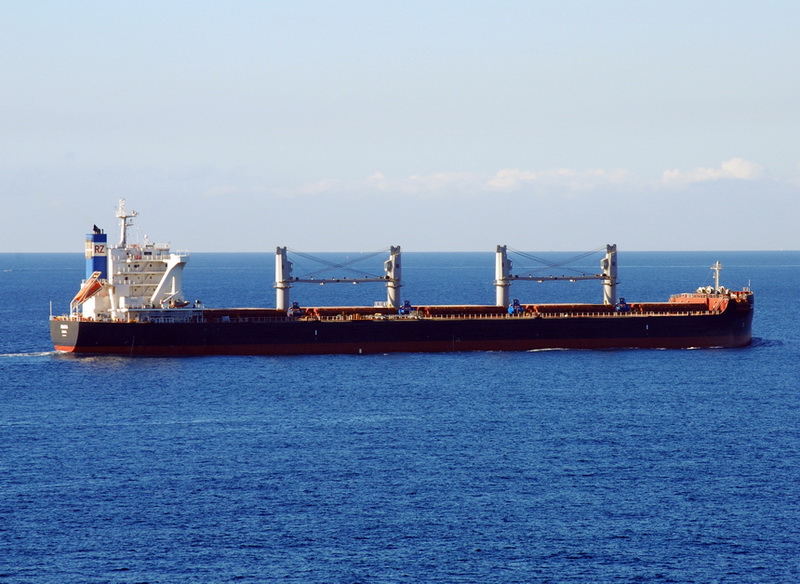
Strait of Gibraltar January 26, 2016
Bildherkunft / Photosource: © Bengt-Rune Inberg
|
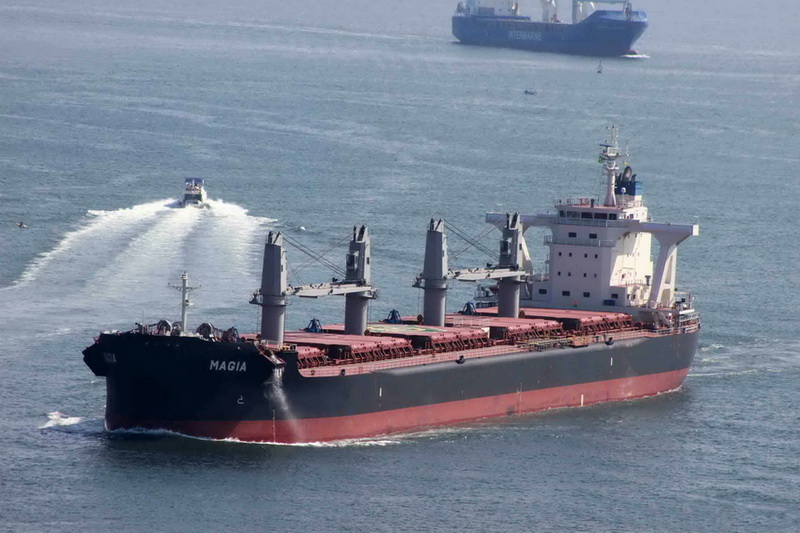
Santos April 9, 2016
Bildherkunft / Photosource: © Roberto Smera
|
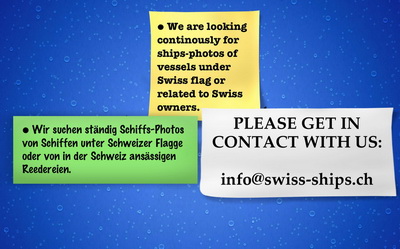
Wir suchen Fotos / Photographs wanted
Bildherkunft / Photosource: © SwissShips / FotoMar
|
|
Diverse Photos PHOTOS VON DER MAGIA, 2015 / PHOTOS FROM MAGIA, 2015 (courtesy Reederei Zürich AG)
Auf der Schiffswerft in Zhoushan / At the shipyard at Zhoushan
|
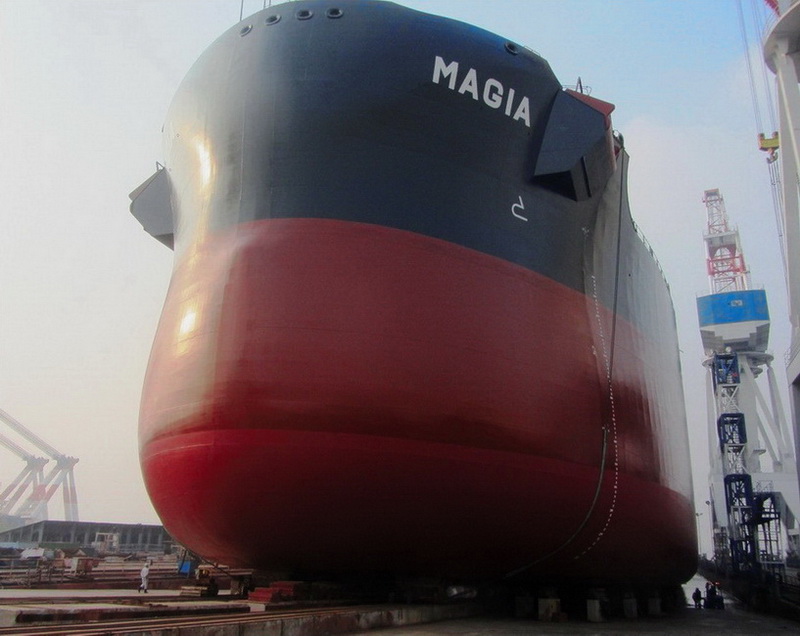
Auf der Schiffswerft in Zhoushan / At the shipyard at Zhoushan
|
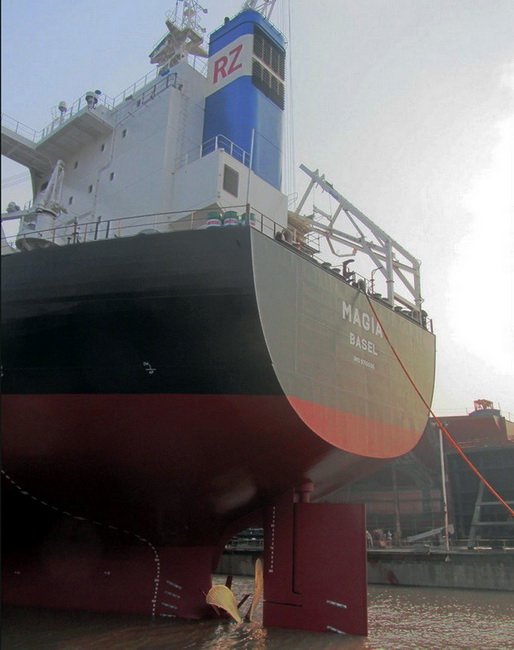
Auf der Schiffswerft in Zhoushan / At the shipyard at Zhoushan
|
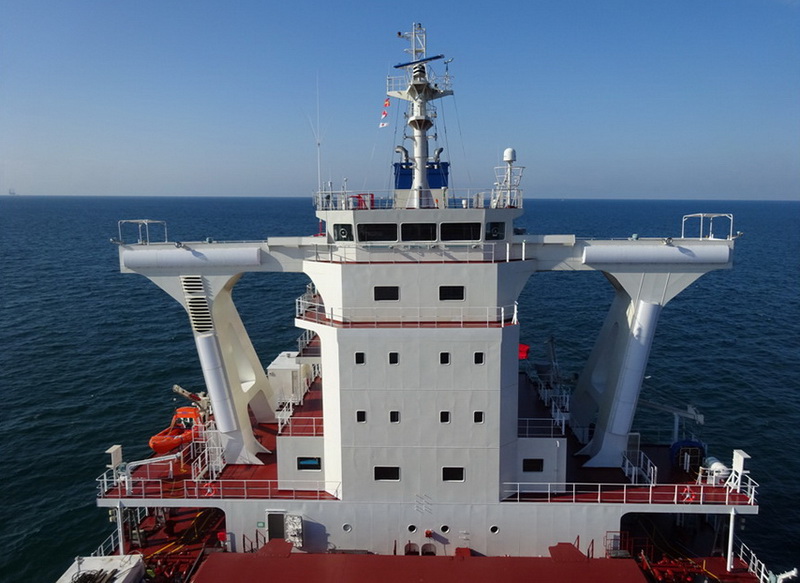
Merkmale des TESS-58 AEROLINE Design sind die schmalen Aufbauten mit den geschrägten Ecken und den halbrunden Verschalungen. Auf der steuerbord Stütze der Brückennock der Luftansaug der Hauptmaschine
Features of the TESS-58 AEROLINE design, are the slim superstructure with the slanted corners and the halfround claddings. On the starboard pillar of the bridge wing, the air intake for the main engine is clearly seen |
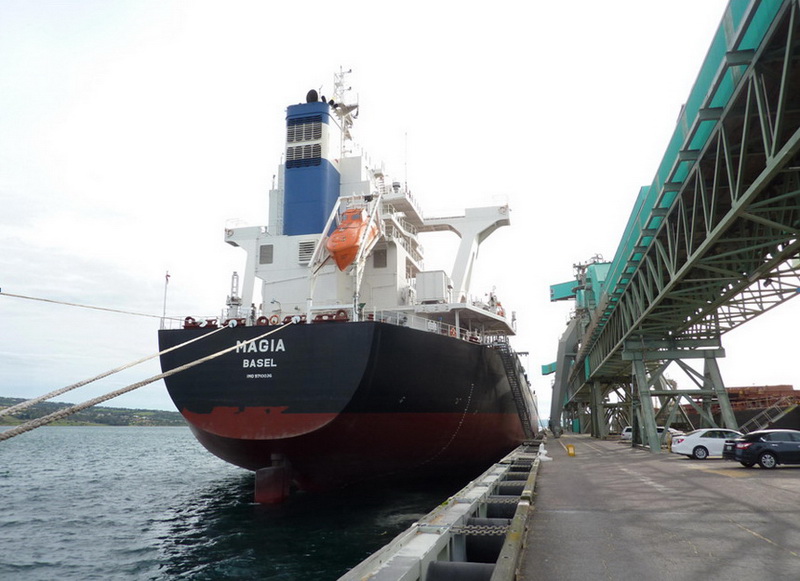
Auf der Schiffswerft in Zhoushan / At the shipyard at Zhoushan
|
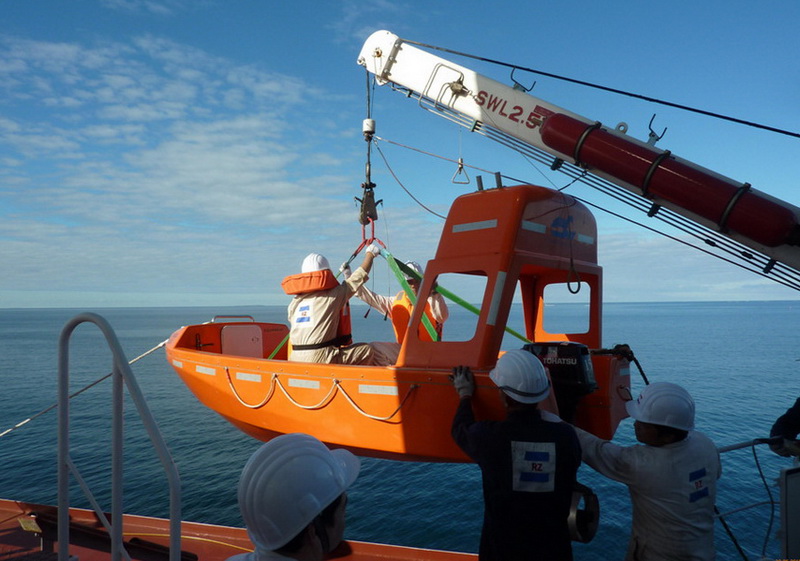
Auf der Schiffswerft in Zhoushan / At the shipyard at Zhoushan
|
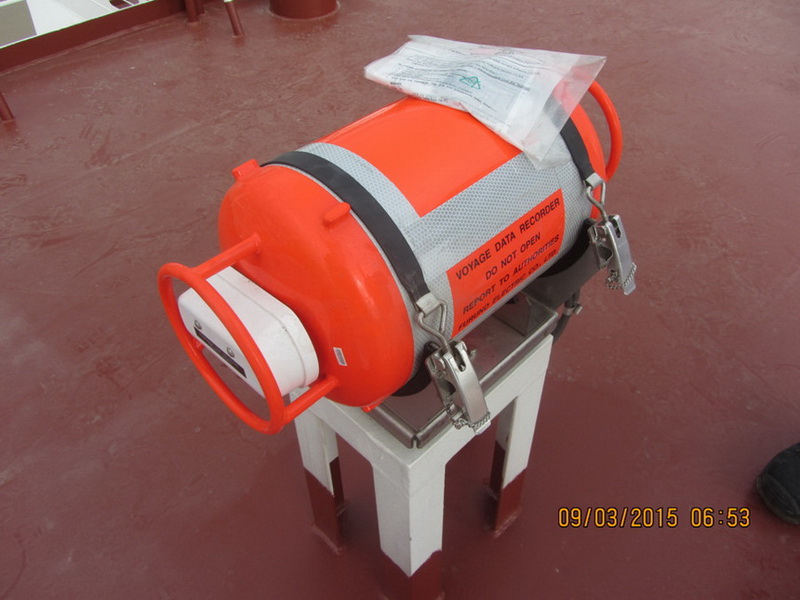
Auf der Schiffswerft in Zhoushan / At the shipyard at Zhoushan
|
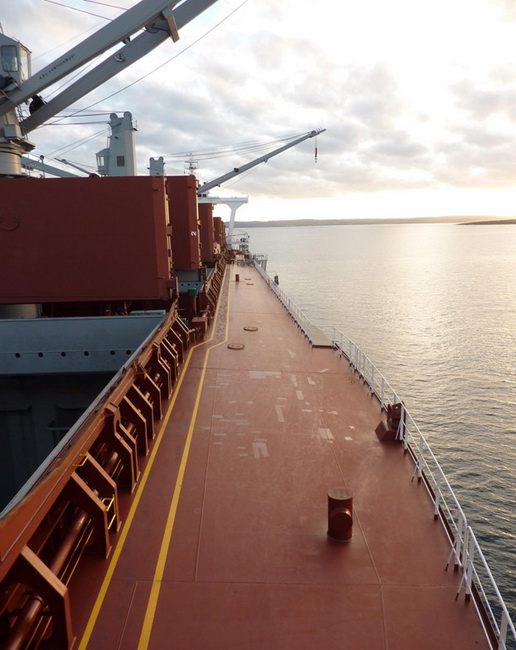
Auf der Schiffswerft in Zhoushan / At the shipyard at Zhoushan
|

Wir suchen Fotos / Photographs wanted
Bildherkunft / Photosource: © SwissShips / © FotoMar
|
